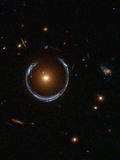Astronomers have potentially identified the largest black hole ever discovered, with an estimated mass of 36 billion times that of the Sun. This black hole is about 10,000 times heavier than the one located at the center of the Milky Way galaxy. The findings were published in the Monthly Notices of the Royal Astronomical Society and resulted from a collaboration between researchers from the Institute of Cosmology and Gravitation at the University of Portsmouth in the UK and the Federal University of Rio Grande in Brazil.
The research team located signs of the new supermassive black hole within a gravitational lens known as the “Cosmic Horseshoe.” A gravitational lens occurs when the gravity of a massive object distorts light and time from objects behind it. The Cosmic Horseshoe was initially discovered by the Hubble Space Telescope in 2007. At its center lies the galaxy LRG 3-757, surrounded by a blue horseshoe shape that represents distorted light emitted from another galaxy located beyond it.
LRG 3-757 is notable for being one of the most massive galaxies ever observed, possessing a mass approximately 100 times that of the Milky Way. It is located about 5.6 billion light-years away from Earth. The distortion of light from this galaxy allows astronomers to infer the presence of a black hole at its center, even though there are no direct observations of it. The team utilized measurements of light motion in the surrounding ring and the velocity of stars in the galaxy’s inner regions, which are consistent with the presence of an ultramassive black hole.
Thomas Collett, a professor of astrophysics at the University of Portsmouth, expressed confidence in the existence of this black hole. “By combining these two measurements, we can be completely confident that the black hole is real,” he stated in a press release. Collett posits that a black hole of such enormous mass likely originated from the merger of two supermassive black holes, a process resulting from the collision of galaxies.
Debates continue among astronomers regarding the potential fate of our own galaxy, the Milky Way, and its neighboring galaxy, Andromeda. While the Cosmic Horseshoe black hole presents compelling evidence, the most massive object currently known is TON 618, which has an estimated mass equivalent to 66 billion suns. This figure nearly doubles that of the Cosmic Horseshoe, but scientists remain cautious about categorizing TON 618 as the definitive most massive black hole due to observational limitations.
Located over 10 billion light-years away, the host galaxy of TON 618 and its surroundings cannot be observed in detail. The information available is primarily based on brightness analysis and theoretical models to estimate size. The uncertainty surrounding TON 618 prevents it from being labeled conclusively as the most massive black hole known.
In contrast, the researchers from Portsmouth argue that the Cosmic Horseshoe black hole offers greater observational certainty. Unlike the distant and somewhat mythical nature of objects like TON 618, the evidence surrounding the Cosmic Horseshoe is more concrete. They assert that their discovery could represent the most massive black hole confirmed to date, paving the way for further exploration of these enigmatic cosmic phenomena.
